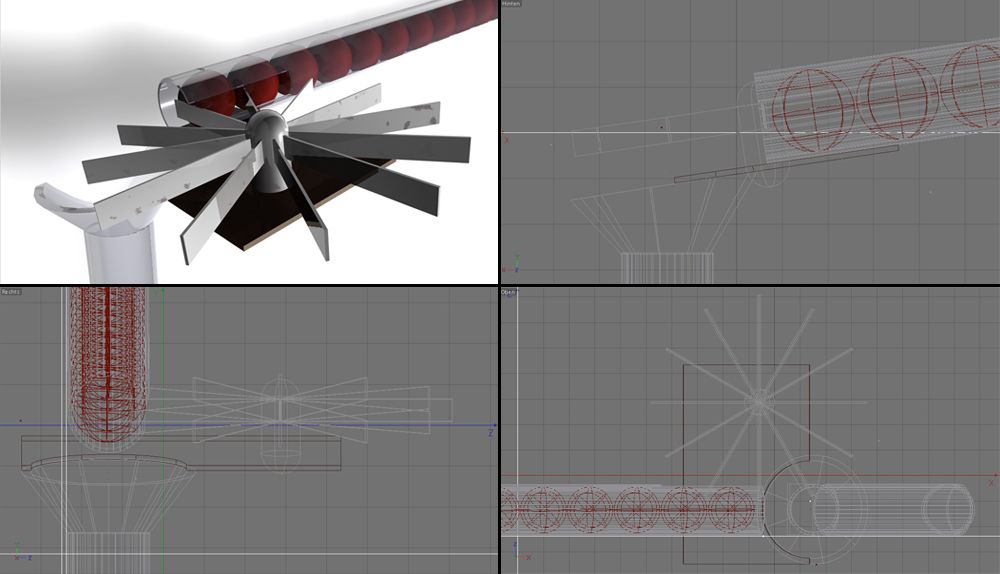15. November 2010

<pre>// Constants ------------------------------------
#define DIR 2 // Direction Pin
#define STEP 3 // Constant
#define LED 4 // LED, lights up each motor rotation
// Variables ------------------------------------
int latchPin = 8; // latch pin for the led row
int dataPin = 11; // data pin
int clockPin = 12; // clock pin
int steps = 0; // number of steps read over serial communication
int sensorValue = 0; // value of the LED sensor
// Setup ----------------------------------------
void setup() {
pinMode(DIR, OUTPUT); // Direction is an output
pinMode(STEP, OUTPUT); // Step is an output
pinMode(LED, OUTPUT);
pinMode(latchPin, OUTPUT);
digitalWrite(LED, LOW); // internal pin up
Serial.begin(9600);
// set led row off
shiftOut(dataPin, clockPin, 0);
shiftOut(dataPin, clockPin, 0);
}
// Loop -----------------------------------------
void loop() {
digitalWrite(DIR, LOW); // set direction
if (Serial.available() >= 1) { // if serial communication is available
steps = Serial.read() -48; // read the number of steps and convert the char into the equivalent number
Serial.println(steps);
// motorrrr
for (int j=0; j<steps; j++) {
Serial.println(j);
digitalWrite(LED, HIGH); // turn single led on
stepOnce(); // do 1 step
delay(850); // time one marble takes from the top to the led row
digitalWrite(LED, LOW);
light(); // ledsssss
}
}
}
// Function Definition ---------------------------
void stepOnce() { // motor rotation
for (int i=0; i<=24; i++) {
digitalWrite(STEP, HIGH);
delay(10);
digitalWrite(STEP, LOW);
delay(1);
}
}
void light () { // led row
for (int j = 0; j < 8; j++) {
//ground latchPin and hold low for as long as you are transmitting
digitalWrite(latchPin, 0);
shiftOut(dataPin, clockPin, 0);
lightShiftPinA(j);
digitalWrite(latchPin, 1);
delay(50);
}
for (int j = 0; j < 8; j++) {
//ground latchPin and hold low for as long as you are transmitting
lightShiftPinA(j);
digitalWrite(latchPin, 0);
shiftOut(dataPin, clockPin, 0);
digitalWrite(latchPin, 1);
delay(50);
}
}
void lightShiftPinA(int p) {
int pin;
pin = 1<< p;
shiftOut(dataPin, clockPin, pin);
}
// the heart of the program
void shiftOut(int myDataPin, int myClockPin, byte myDataOut) {
// This shifts 8 bits out MSB first,
//on the rising edge of the clock,
//clock idles low
//internal function setup
int i=0;
int pinState;
pinMode(myClockPin, OUTPUT);
pinMode(myDataPin, OUTPUT);
//clear everything out just in case to
//prepare shift register for bit shifting
digitalWrite(myDataPin, 0);
digitalWrite(myClockPin, 0);
//for each bit in the byte myDataOut�
//NOTICE THAT WE ARE COUNTING DOWN in our for loop
//This means that %00000001 or "1" will go through such
//that it will be pin Q0 that lights.
for (i=7; i>=0; i--) {
digitalWrite(myClockPin, 0);
//if the value passed to myDataOut and a bitmask result
// true then... so if we are at i=6 and our value is
// %11010100 it would the code compares it to %01000000
// and proceeds to set pinState to 1.
if ( myDataOut & (1<<i) ) {
pinState= 1;
}
else {
pinState= 0;
}
//Sets the pin to HIGH or LOW depending on pinState
digitalWrite(myDataPin, pinState);
//register shifts bits on upstroke of clock pin
digitalWrite(myClockPin, 1);
//zero the data pin after shift to prevent bleed through
digitalWrite(myDataPin, 0);
}
//stop shifting
digitalWrite(myClockPin, 0);
}
